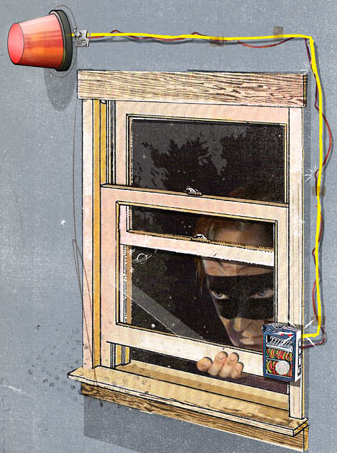Many methods have been improvised, invented, and hacked to sense sudden movements, acceleration, and vibration. Today tiny, solid-state accelerometers are available to do these jobs, and they’re embedded in many smartphones, tablets, and electronic game controllers. These miniature accelerometers are available for reasonable prices, or you can use the smartphone itself for vibration detection.
DIY vs. Solid-State Vibration Sensors
But there’s no need for specialized accelerometer circuits if all your project needs is a simple vibration detector. Many DIY methods are available — and some are more sensitive than the solid-state accelerometers in smartphones.
This can be demonstrated with an Einstein Tablet educational computer (einsteinworld.com). The Einstein can store data from up to 16 sensors, including its own internal 3-axis accelerometer and photodiode. These 2 sensors allow us to directly compare a solid-state accelerometer with a DIY vibration sensor made of a light source and the Einstein’s photodiode.
First, transform the Einstein into a pendulum by suspending it from a tabletop with 2″ shipping tape. The photodiode (the dark square sensor below) should face down and the screen should face away from the table. Place an LED flashlight on the floor and point it up at the photodiode.
Select the accelerometer and photodiode options by checking them in the Einstein’s launch window. Set the sample rate at 10 per second, the sampling duration at 50 seconds or more and the sensitivity of the photodiode at 0–600 lux. Press the Start arrow and then pull the Einstein 1″ or so away from the vertical. Then release the tablet so that it swings back and forth. Experiment with the placement of the flashlight for best results.
The chart below compares the movement response of the z-axis of the Einstein’s accelerometer and its photodiode. The photodiode is plainly more sensitive to movement, and even shows a periodic wobble in the swing of the tablet. Clearly, a simple pendulum or cantilever made from a light source and a photodiode can provide a very sensitive movement and vibration detector.
Make a Piezoelectric Vibration Sensor
Here’s another DIY method that’s simple and doesn’t need to be shielded from external light. A piezoelectric crystal or ceramic generates a voltage when it is bent or struck. A very simple vibration sensor can be made from the type of piezo ceramic disc that emits tones and sounds in watches, phones, greeting cards, and alarms.
The schematic below shows a circuit that flashes an LED and emits tone bursts when piezo disc PZ1 (mine was salvaged from a greeting card) is touched or vibrated. The piezo disc is connected to the inverting input of a TLC271 or similar operational amplifier connected as a voltage comparator. A voltage divider formed by potentiometer R3 is connected to the noninverting input of the op-amp.
In operation, R3 is adjusted until the output of the op-amp switches from low to high. This switches off the tone generator formed by a 4011 quad NAND gate. A very slight mechanical shock will cause PZ1 to generate a voltage that will switch the comparator output from high to low. This will flash the LED and cause the 4011 to generate a tone burst.
This circuit can be built on a solderless breadboard that allows for easy modifications. For example, the tone frequency can be decreased by increasing the value of C1. The sound volume can be increased by replacing PZ2 with the input side of a standard audio output transformer having an input impedance of 1,000Ω and an output impedance of 8Ω (RadioShack 273- 1380 or equivalent). Connect a small 8Ω speaker to the transformer’s output. For even more volume, connect pin 4 of the 4011 and ground to the input of an external amplifier.
The sensitivity of the circuit can best be demonstrated by connecting PZ1 to the circuit with a pair of 4″, 24-gauge jumper wires as shown in Figure D. Solder one end of each wire to the connection points on the backside of the piezo disc. Connect the other 2 ends of the wires to the circuit so that the piezo disc is cantilevered, suspended about 1″ over the breadboard.
When PZ1 is still, adjust R3 until the LED glows and the tone generator is on. Then back off on R3 until both the LED and the tone are off. Now when you barely touch the piezo disc, the LED and tone generator should respond. Tap the piezo disc so that it bounces up and down, and the LED and tone will respond accordingly.
PZ1 can be kept in the cantilever mode or cemented or clipped to a wall, curtain, step, car, etc. The circuit can be made much more sensitive by cementing to its upper surface a stiff metal rod with a small weight mounted on its free end. Footsteps can be detected when a piezo disc with an attached rod is mounted on or under a flat surface such as a wood floor or step.
Going Further
Sensitive pendulum and cantilever vibration sensors can be made from hardware found in almost any workshop. Suspend a weight from the end of a vertical metal rod or mount it on the end of a horizontal metal cantilever. Mount a machine screw and nut near the movable weight so the screw can be adjusted to nearly touch the weight or its rod. You now have a movement and vibration sensitive on-off switch.












